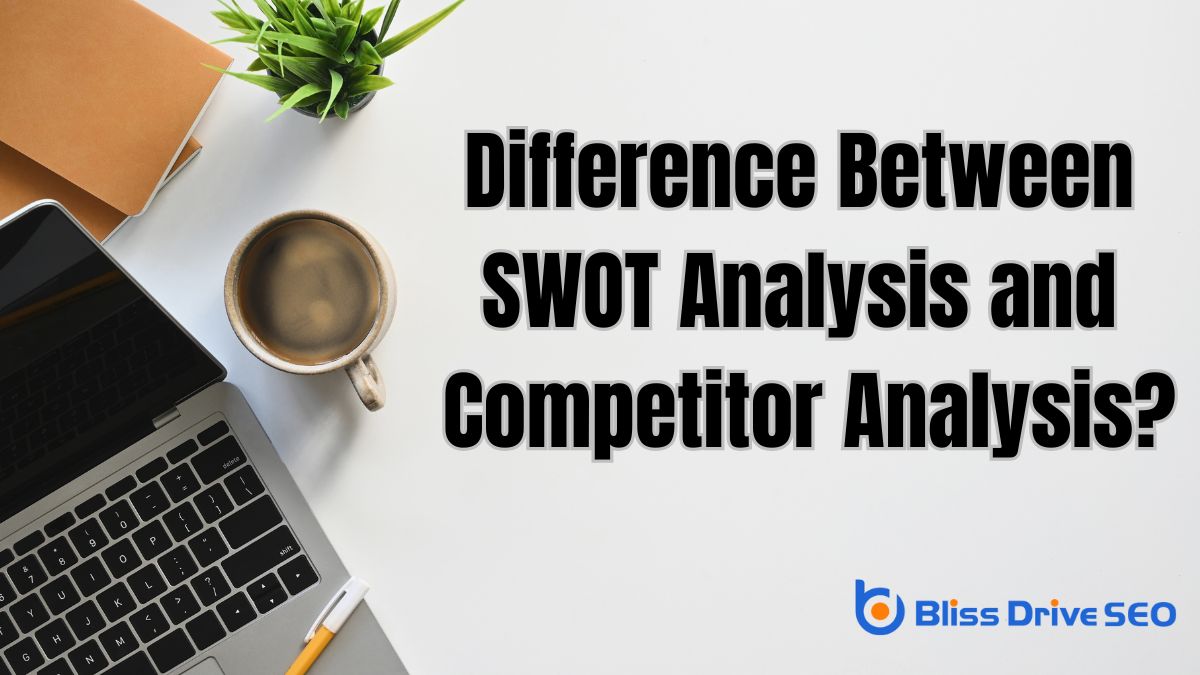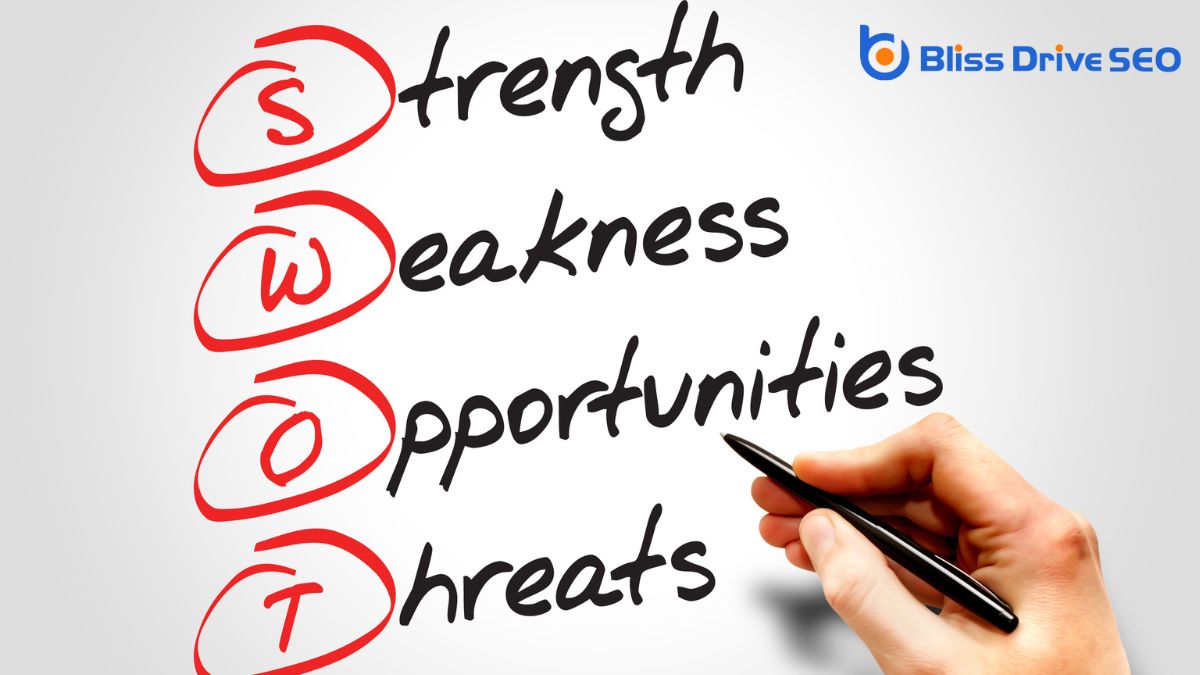Digital Marketing Services
Learn More About Us

When you're maneuvering through the world of strategic planning, you'll often encounter both SWOT analysis and competitor analysisEvaluating the strengths and weaknesses of competitors’ SEO strategies.. You might wonder how these tools differ and why they're essential for your business. SWOT analysis helps you evaluate your internal strengths and weaknesses alongside external opportunities and threats. Competitor analysis, on the other hand, focuses on understanding your rivals' strategies and market position. Each offers unique insights, but how do they work together to shape your business strategy? There's a lot more to uncover about their synergy and impact on decision-making.

A SWOT analysis is a strategic tool that helps you evaluate a business's Strengths, Weaknesses, Opportunities, and Threats. By using this tool, you gain a clear insight into both internal and external factors affecting the business.
To start, identify the business's strengths—attributes or resources that give it an advantage over competitors. These could include a strong brand, loyal customer base, or unique technology.
Next, consider the weaknesses. These are limitations or areas where the business might be at a disadvantage. Perhaps there's a lack of expertise in certain areas, outdated technology, or a weak online presence. Acknowledging these helps you address potential problems before they escalate.
Then, look at opportunities—external factors that the business can capitalize on. This could be emerging markets, trends favoring the industry, or changes in regulations that benefit the business.
Finally, identify threats that could harm the business. These might include new competitors, changing consumer preferences, or economic downturns. Understanding these threats allows you to develop strategies to mitigate their impact.
While understanding a business's internal and external factors through SWOT analysis is essential, another significant aspect of strategic planning involves competitor analysis.
You're not just looking at your business in isolation; instead, you're examining how it stacks up against others in the market. Competitor analysis helps you understand the strengths and weaknesses of your competitors, what they're doing right, and where they're falling short. This insight allows you to identify opportunities to differentiate your business and gain a competitive edge.
Start by identifying who your competitors are. They're not just the obvious ones who sell similar products; they can also be businesses offering alternative solutions to your customers' needs.
Once you know who you're up against, explore their marketing strategies, pricing, products, customer reviews, and brand positioningThe strategy of placing a brand in a specific niche in the market to distinguish it from competitors.... Look at how they engage with their customers and what kind of reputation they've built.
When comparing SWOT analysis and competitor analysis, it's crucial to understand their distinct focal points. SWOT analysis examines your business's internal and external environment by identifying strengths, weaknesses, opportunities, and threats.
It's an all-encompassing tool for understanding what your business excels at and where it can improve. You focus on internal factors like resources and skills, as well as external influences like market trends and competition. This analysis helps in crafting strategies that capitalize on strengths and opportunities while mitigating weaknesses and threats.
On the other hand, competitor analysis zeroes in on your competitors. It involves detailed research on their strategies, strengths, weaknesses, market position, and customer base.
You examine what your competitors are doing well, where they're falling short, and how they position themselves in the market. This analysis helps you identify gaps in the market you can exploit and anticipate competitive moves.
You're not just looking at your own business's capabilities but at the broader competitive landscape.
Understanding the unique focus of SWOT and competitor analyses sets the stage for leveraging them in your business strategy.
With SWOT analysis, you'll identify your business's internal strengths and weaknesses alongside external opportunities and threats. This tool helps you gain a thorough view of where your business stands and how it can grow. You can prioritize strategic initiatives that capitalize on strengths and opportunities while addressing weaknesses and threats, ensuring a balanced approach to growth.
On the other hand, competitor analysis allows you to understand your rivals' strategies, strengths, and weaknesses. Use this insight to carve out a unique position in the market. Identify gaps in competitors' offerings or areas where they excel, and adjust your strategy accordingly. This analysis helps you anticipate market shifts and respond proactively, keeping your business ahead.
Both analyses play distinct roles in forming your business strategy. While SWOT provides a broader internal and external perspective, competitor analysis zeroes in on the market landscape.

Integrating SWOT and competitor analyses can greatly bolster your strategic planning efforts. By combining these tools, you gain a thorough understanding of both your internal capabilities and the external landscape.
Start by conducting a SWOT analysis to identify your strengths, weaknesses, opportunities, and threats. This gives you a clear picture of your business's internal and external factors.
Next, engage in competitor analysis. Examine your competitors' strengths, weaknesses, strategies, and market positions. This helps you spot gaps in the market and areas where you can outshine them.
When you merge insights from both analyses, you can prioritize actions that leverage your strengths against competitors' weaknesses or capitalize on market opportunities they haven't tapped into.
For example, if your SWOT analysis reveals a strong customer service team and competitor analysis shows rivals with poor service, you can emphasize this strength in your marketing strategy.
Combining the analyses guarantees you're not just reacting to competitors but proactively shaping your market position. You're better equipped to make informed decisions, anticipate market shifts, and create strategies that align with your capabilities while staying ahead of the competition.
In strategic planning, you'll find that SWOT and competitor analysis are essential tools. SWOT helps you focus on your business's internal and external factors, identifying areas to improve. Competitor analysis, on the other hand, lets you understand your rivals and their strategies. By integrating both, you gain a thorough view of your market position and make informed decisions. Use them together to strengthen your strategy and enhance your business's competitive edge.
